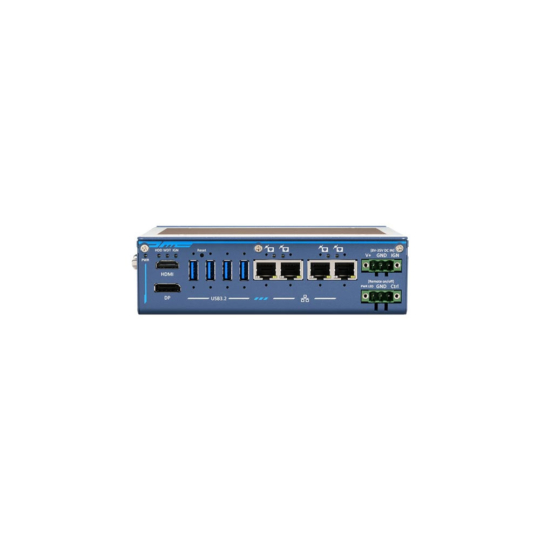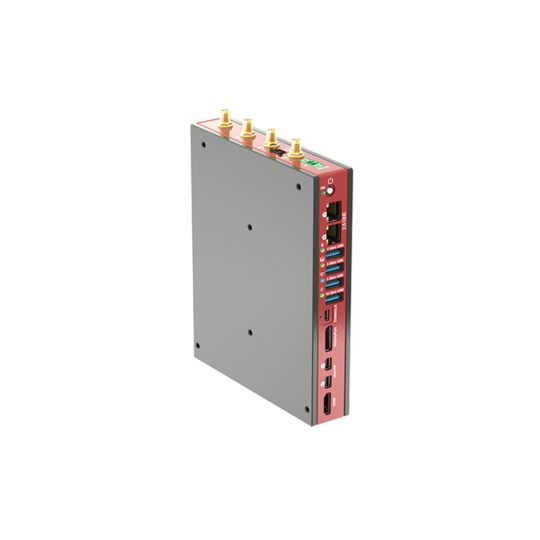Edge Computers for Confined, Sealed, and Waterproof Enclosures
Factors Transforming Industrial Edge Computing
Industrial edge computing is evolving rapidly to meet the demands of manufacturing production lines, smart factory logistics, agriculture, and autonomous vehicles. Four main drivers are propelling this advancement: the integration of AI and machine learning, miniaturization for enhanced portability and confined space instalments, improved connectivity via 5G and low-latency networks, and increased energy efficiency. These drivers are enabling industrial edge computers to perform more complex, data-intensive tasks directly at the source of data generation, providing real-time insights and autonomous decision-making capabilities in environments where connectivity, space, and power resources may be constrained. As industrial edge computing progresses, these foundational elements are helping industries boost operational efficiency, optimize resources, and achieve new levels of responsiveness in mission-critical applications.
These four drivers highlight the rapid evolution of industrial edge computing and its growing importance in supporting high-performance applications in harsh environments:
Integration of AI and Machine Learning
The integration of artificial intelligence (AI) and machine learning (ML) at the edge is transforming the capabilities of our industrial box PCs. Integrated with specialized AI accelerators, such as GPUs and NPUs optimized for the edge, an industrial PC for edge AI can now process complex data locally, enabling predictive maintenance, autonomous decision-making, and real-time anomaly detection. These low-latency insights help our customers significantly impact operational efficiency and safety.
Miniaturization for Confined Spaces & Portability
A strong trend is emerging toward compact edge computers, driven by the demand for high-performance computing systems that can operate effectively in space-constrained or mobile environments. This trend supports edge deployments in applications such as drones, robotics, and compact sensor arrays, where size, weight, and power considerations are critical.
Enhanced Connectivity via 5G and Low-Latency Networks
Integrating 5G and low-latency communication technologies is reshaping the connectivity landscape for edge computing. With 5G’s high bandwidth and low latency, edge computers can now transmit and receive large volumes of data almost instantaneously, enabling more complex interactions between distributed edge nodes and central data centers.
Energy Efficiency and Power Optimization
Energy-efficient designs are paramount for edge devices deployed in off-grid or power-sensitive environments. Innovations in low-power processors, dynamic power management, and efficient thermal design have led to significant advancements in edge computers which help with thermal management and powering through sources such as solar or battery systems where traditional power infrastructure may be lacking or unstable.
Conduction Cooling with Flattop Heatsink Industrial Edge Computers
Edge computing devices are experiencing growing demand for computational power, which generates substantial heat. To address this, traditional convection cooling methods that rely on airflow are being replaced by more efficient conduction and passive cooling techniques. These approaches not only meet thermal demands but also maintain environmental sealing for sensitive components. As edge computing expands into challenging environments—such as vehicles, ships, drones, and semiconductor equipment—it must withstand extreme conditions, including intense heat, frigid temperatures, high humidity, dust, and mechanical vibrations. Such conditions create unique challenges, as hardware must be both powerful and resilient. To protect delicate electronics, rugged industrial computers are often housed in sealed or waterproof enclosures that shield against environmental factors like water, dust, and contaminants.
At Things Embedded, we help customers find solutions that effectively dissipate heat within confined, sealed spaces while preserving durability and protection. Passive cooling methods, such as heat sinks and thermal conduction pads, are increasingly being adopted for rugged edge computing. These methods use materials with high thermal conductivity to pull heat away from critical components and disperse it across the enclosure surface, improving heat management without compromising performance.
One innovative approach involves attaching the industrial PC to a larger cooling medium, which expands the cooling area. By replacing traditional heatsink fins with a broad, flat heat spreader, the industrial PC can connect directly to the surface of a cabinet or enclosure, effectively transforming the cabinet itself into an extended cooling surface. Installing an industrial PC with a flat-top heatsink requires careful attention to ensure optimal heat dissipation and secure adhesion. Reserved screw holes in the flat-top heatsink allow for a stable and effective attachment to a cabinet surface. For best results, mounting the system onto metal surfaces—such as aluminium plates, which are excellent conductors—supports surface cooling. Cooling performance will vary depending on factors like the material and surface area of the adhesion, as well as the installation environment. For instance, installations in well-ventilated areas may improve heat dissipation, whereas confined spaces could limit it. Considering these variables allows the industrial PC to achieve secure placement and effective thermal management.
A flat-top design not only enhances thermal dissipation but also reduces the industrial computer’s height compared to traditional heatsink technology, optimizing space efficiency. This innovative design minimizes the machine’s overall footprint, making it exceptionally compact and suitable for integration into cabinet installations, automation equipment, and other applications where space is limited, offering a practical and versatile solution without sacrificing performance.
Our product lineup includes an increasing number of systems with conduction cooling plates for optimal thermal transfer within cabinets and waterproof enclosures. We offer embedded systems built on Intel, AMD, and NVIDIA Jetson technology to address a range of fanless edge computing needs, from ultra-low-power applications to high-performance AI tasks. Learn more about their specific use cases below:

Low Power Intel Alder Lake CPUs
Intel Alder Lake-N CPUs with low-power variants are well-suited for Internet of Things (IoT) gateways, data acquisition, and edge sensors where power efficiency and performance must be balanced. These CPUs can handle lightweight tasks such as monitoring sensor data, basic analytics, and local data aggregation, making them ideal for distributed networks like smart city deployments, factory floor monitoring, and environmental monitoring in agriculture. Additionally, their low-power consumption extends device lifespan in remote or battery-powered setups.

High-Performance Intel Core CPUs
The 35W high-performance Intel Core CPUs provide a balance between processing power and energy efficiency, making them ideal for edge AI applications requiring real-time processing and inferencing, such as machine vision and quality inspection in industrial automation. These CPUs can handle high-resolution video feeds and apply AI algorithms to detect defects, classify objects, or monitor production processes. In transportation, they’re effective in autonomous driving systems and traffic monitoring setups where real-time data processing at the edge reduces latency and improves response times.

AMD Ryzen Embedded 8000 Series CPUs
The AMD Ryzen Embedded 8000 series CPUs bring multi-core, high-performance processing capabilities to fanless edge systems, ideal for applications requiring multitasking and graphical rendering. These CPUs are well-suited for industrial control systems, where multiple subsystems and processes need to be managed concurrently, as well as for digital signage. In signage, these CPUs support high-definition graphics and interactive interfaces in places like retail or smart buildings, without the need for active cooling, ensuring reliable operation in high-traffic or outdoor environments.

NVIDIA Jetson Orin SOMs
The NVIDIA Jetson Orin series of System-on-Modules (SOMs) are optimized for AI workloads and provides exceptional GPU and deep learning performance within a compact, energy-efficient package. It is particularly suited for autonomous systems like drones, robotics, and mobile edge devices where complex AI processing, computer vision, and inferencing are required at the edge. A Jetson Orin PC can process data locally, enabling rapid decision-making for applications like autonomous mobile robots in logistics, agricultural drones for crop monitoring, and surveillance drones in remote or hazardous environments.
Struggling With Heat Dissipation At The Edge?
Tell us about your application and a member of the team will get right back to you.
